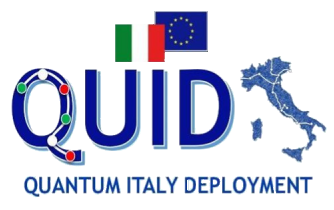QUID implementation work plan is organized in work packages that covers the challenges of deploying a national Quantum Communication infrastructure. The core is the infrastructure, here made of fibres, nodes, QKD devices. The implementation needs this infrastructural work, like the skeleton and the main organs, but then QUID addresses the needs for orchestration, management and joining tradition and quantum security. In other words, we need operations for the infrastructure to work. The other workpackages aim to build a solid basis for the deployment and the future consolidation are devoted to Innovation, Training, and Impact.
Lead Beneficiary: INRIM
Objectives
- Grant fulfillment as intended on-time, on-cost, on-quality
- EC and partners satisfaction
- Management of deployment time scheduling and coordination
Description
WP1 is devoted to coordination of the different activities, with particular attention to the timeline of implementations and deployment, early warning on delay and problems for active risk mitigation and removal actions, partners’ collaboration, geographical homogeneous advancement in deployment. WP1 implements the bodies for decision-taking within the project, and organize regular meetings of the partners.
Lead Beneficiary: INRIM
Objectives
- Definition and Design of the initial Italian QKD deployment
- Implementation of the Deployment
Description
WP2 is in charge of the architectural and punctual deployment, and implements the main concept of QUID: using an existing national backbone to connect the Quantum Metropolitan Area Networks in the main Italian towns, laying systems and initial QMANs. WP2 will design and realize at least 14 nodes in Q-MAN, over 9 towns (Turin, Milan, Padua, Bologna, Trieste, Florence, Rome, Naples, L’Aquila). As well, WP2 implements the quantum regional connections (long hauls) over 2 long distance hauls, one in the northeast and one in the centre Italy. Last, 2 nodes in space-to-ground sites are realized and 1 free space node to a use case is involved.
Lead Beneficiary: Telsy
Objectives
- integration of quantum and traditional cybersecurity
- fostering key management at the nodes
- improving the trusted node management
- fostering management of fiber infrastructures delaying QKD and data traffic
Description
WP3 deals with all the necessary activities to harmonize existing and traditional cybersecurity with the quantum systems and networks. WP3 fosters the key management in devices, nodes, and interfaces. A dedicated activity is devoted to management of quantum key distribution and telecommunication operations, to prepare for sharing the fibre infrastructure in Q-MAN networks. The application level of QKD is supported in WP3, as well a dedicated activity to manage the QKD between space and terrestrial segments.
Lead Beneficiary: UNIVAQ
Objectives
- Developing the TRL of innovative technical solutions
- Including by design this development in further consolidation of the deployment
- Preparing high-key rate solutions to sustain effective national deployment
- Preparing more effective free-space QKD deployment
Description
WP4 is devoted to innovation, hence to techniques that are not yet at the highest technology readiness level, but that are suited to provide solutions for the open challenges in QKD. Implementation and study activity is devoted to improve key rates by new protocols and technique. As well, the free-space component of the architecture search for new solutions to cope with free-space limits.
Lead Beneficiary: Leonardo
Objectives
- Training and Education
- 2) Pool of Use Cases
- Coordination with Testing and Validation Facilities for QKD
- After- QUID roadmapping
Description
WP5 implements activities for dissemination, education, and strong coordination with use cases, EuroQCI and further steps of the national deployment as a follow up of the initial steps. Dissemination events are realized to improve the awareness of QKD solutions for real use cases: in particular, a pool of use cases is created that are involved in the nodes implementation in WP2, but the concept is to open this pool to new use cases in view of further steps and level of deployment. Education is pursued both internally in the consortium, building on different expertise (telecom operations, traditional cybersecurity, innovative research, quantum devices a protocols), and to larger audiences, provided dedicated courses at universities and open to companies interested in quantum security. Coordination with EuroQCI has a focused activity in WP5, as well the roadmapping to follow up with the project to foster the deployment of other nodes and consolidate the nodes deployed in the project.
